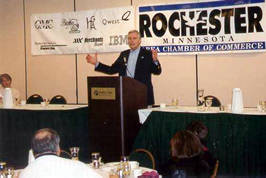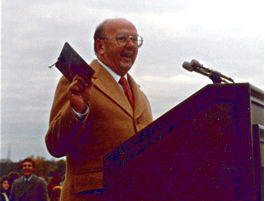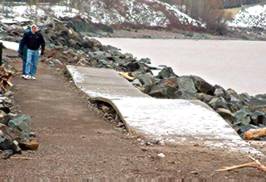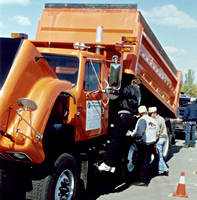 |
 |





 |
 |
 |
 |
 |
 |
Metro area kicks off construction season March 28
|
 |
 |
 |
The image above promotes
National Work Zone Awareness Week (April 8-12). Statewide Mn/DOT has scheduled
245 construction projects with an estimated total cost of $1 billion.
|
Winter hasn’t completely loosened its hold over the state, but nonetheless,
Minnesota’s "other season" begins officially on March 28 in the Twin
Cities Metro area.
That’s when Mn/DOT Metro Division kicks off its summer construction season
with a news conference March 28 at the Cedar Avenue truck station at 10 a.m.
Metro will highlight 56 Twin Cities area construction projects for the news
media, including 40 new projects.
Around the state, Mn/DOT has scheduled 245 construction projects with an estimated
total cost of $1 billion. The federal government will supply about $525 million
towards these projects while the state will provide about $370 million.
Those figures tell an interesting story, according to Mn/DOT Commissioner Elwyn
Tinklenberg.
"Minnesota is fortunate to be one of the states that receives more in
federal highway construction dollars than we send to Washington," Tinklenberg
said. Since 1990, Minnesota has received an average of $1.10 from Washington
for every $1 sent.
Work zone safety: the summer campaign begins
Highway construction projects, of course, mean work zones on heavily traveled
highways—as well as safety issues for workers and people passing through work
zones. To highlight the importance of work zone safety to the public, this year
Mn/DOT will roll out its summer work zone safety publicity campaign—"See
Orange. We’re in the Work Zone Together"—during National Work Zone Awareness
Week (April 8-12).
As part of the national campaign, U.S. Rep. James Oberstar, the ranking Democrat
on the House Transportation and Infrastructure Committee, will unveil a traveling
memorial on April 9. Mn/DOT cosponsors the memorial,
which includes the names of three Mn/DOT employees who were killed in work zones.
The need for awareness increases
"Working with the National Work Zone Awareness campaign is about bringing
the attention of the motoring public and media to the fact that nearly 900 men,
women and children are killed senselessly in work zones each year," according
to Jon Jackels, pavement marking and work zone engineer.
Nationally, work zone crashes have increased dramatically—up 25 percent from
the previous year. In Minnesota, however, the increase has been much less, despite
more construction sites. That’s also despite a 40 percent increase in vehicle
miles driven on a highway system that’s increased available lane miles by less
than 2 percent.
"We would like to believe a big part of that is the education and training
Minnesota does up front," said Mary Meinert, work zone safety awareness
coordinator. "Mn/DOT also offers training to construction companies—including
their safety officers and truck drivers, as well as consultants who sign projects."
|
back

|
 |
Internal audit finds Mn/DOT needs to improve oversight, compliance in some areas
|
 |
 |
In response to a recent department internal audit, Mn/DOT will improve project
oversight to ensure that contractors and public agencies working under department
supervision meet state and federal regulations.
The audit, which covered the fiscal year ending June 30, 2001, was part of
Mn/DOT’s annual review of its financial statements and federal programs. The
department forwards the results of its internal audit to the Office of the Legislative
Auditor each year for review. The legislative auditor publicly released its
report about Mn/DOT’s findings on March 26.
"Our internal audit findings indicate we have areas in which we need to
improve," Commissioner Elwyn Tinklenberg said. "Fortunately, we have
already defined processes to make us more efficient and accountable and are
taking measures to address all of the concerns raised."
The audit identified seven areas of concern, including suggesting that MnDOT
did not provide adequate oversight to Hennepin County engineers in properly
disposing of lead paint residue removed from the Washington Avenue bridge in
Minneapolis. According to the original audit report, the Hennepin County contractor
improperly disposed of 117 tons of bridge lead paint blasting residue at a landfill
instead of disposing it at a hazardous waste treatment facility.
However, Tinklenberg said, Mn/DOT has been working with Hennepin County on
this issue and recently received documentation from Hennepin County officials—not
available at the time of the audit—that verifies otherwise. According to the
documentation, the blasting residue was tested and deemed to be non-hazardous
waste by state and federal standards.
"The documentation indicates that the contractor safely disposed of the
material in a landfill without endangering the environment and without violating
state and federal regulations and standards," Tinklenberg said. "Had
the findings been otherwise, Mn/DOT could and would have exercised its authority
to issue penalties and withhold federal funding."
Another area of concern identified in the audit were missing reports that adequately
document the disposal of asbestos from the demolition of 40 homes. Project staff
has assembled and can verify proper disposal in 39 of the 40 homes. In the remaining
home—demolished in 1998—project staff is working with the contractor to verify
asbestos disposal. It is likely that in this case, as with many in this project,
the home either contained no asbestos, contained below-threshold amounts or
was moved rather than demolished. In any of these instances, no reports are
required to be filed.
The focus of the FY 2001 audit included state highway construction expenditures;
grants for airport improvement; grants to local governments for road construction
and maintenance; local bridge and transit project disbursements; rail service
improvement loan balances, and highway user tax transfers.
Click here to read the complete audit
report and Mn/DOT's response.
|
back

|
 |
SMT approves changes to Bridges and Structures, Traffic Engineering
|
 |
 |
The Senior Management Team March 19 approved recommendations for changes to
the Office of Bridges and Structures and the Office of Traffic Engineering.
The recommendations are part of the department’s ongoing Shaping Our Future
effort to adapt to changing state and national priorities, the economic climate,
new technology and customer needs.
SMT approved the recommendation to maintain the responsibilities of the Office
of Bridges and Structures as a Central Office function within the Program Support
Group. Feedback from the districts and Metro Division indicate that those specialty
functions, like bridge design, work best when centralized as they are now.
Districts that have a high number of fracture-critical bridges (those bridges
in which the loss of a single supporting piece could cause collapse) will continue
to perform these special inspections at the district level in addition to their
regular annual inspections. The Central Office will assist in high-demand districts
and will provide the expertise to those districts that have less demand. This
is consistent with how the work has been distributed in recent past.
The Office of Traffic Engineering also will see changes. All plan development
for lighting, signing and signals will be distributed to the districts and to
Metro Division. The Central Office will be responsible for audit, standardized
plan development and training functions.
The process for traffic agreements will also change. Agreement writing will
be the responsibility of the districts. The Office of Traffic Engineering will
establish a process to ensure that the essential elements are included in the
agreements. The Pre-Letting Section in the Office of Technical Support will
ensure that agreements are in place.
Nelrae Succio, assistant division director for Program Delivery, and Keith
Shannon, acting assistant Metro Division engineer, will lead the development
of an implementation plan to transition these functions to the districts.
Click here for more information about Shaping
Our Future. Send questions to change@dot.state.mn.us
or to Change, Mail Stop 150.
By Sonia Pitt
|
back

|
 |
Tinklenberg stresses long-term funding needs at Rochester community forum
|
 |
 |
 |
In Rochester on March
23, Commissioner Elwyn Tinklenberg spoke of the need for long-term, multi-modal
transportation funding to meet Minnesota’s growing transportation needs.
Photo by Brian Jergenson
|
Commissioner Elwyn Tinklenberg stressed the importance of long-term, multi-modal
transportation funding to meet Minnesota’s growing transportation needs in Rochester
on Saturday, March 23.
Tinklenberg made his remarks at the Rochester Area Chamber of Commerce’s "Eggs
and Issues" monthly breakfast forum that drew nearly 100 people including
House Speaker Steve Sviggum, other legislators and community and business leaders.
Issues he addressed included funding mechanisms such as raising the state gasoline
tax, now 20 cents per gallon, to keep pace with growing needs and projects such
as rebuilding nine miles of Hwy 52 in Rochester.
He also addressed other issues including Mn/DOT’s use of the streamlining process
to accelerate project completion in areas such as right of way acquisition and
designing and building highway projects.
|
back

|
 |
Mentoring program helps build skills, knowledge
|
 |
 |
The hardest part about a new job or changed job duties is often subtle—from
learning how to navigate the cafeteria to knowing how to speak up effectively
in staff meetings.
Mn/DOT’s mentoring program can help make a job transition easier.
"Mn/DOT’s mentoring program pairs employees looking for guidance and support
with more experienced employees," explains Emeric Pratt, mentoring program
coordinator. "The goal is to build and retain a productive, satisfied and
knowledgeable workforce through the exchange of information relating to department
culture, work style and career development opportunities."
"The mentoring program is also part of our Shaping Our Future effort to
build the skills within Mn/DOT needed to deliver products and services today
and in the future," says Linda Bjornberg, director, Management Operations
Group. "Mentoring is a continuum of learning to help employees be more
successful in the new organization."
From the most experienced employee to the newest members of our workforce,
there is personal benefit to all who participate, Bjornberg said. "Mentoring
opens up communications across functions and classifications and encourages
new ways of thinking. It will help Mn/DOT retain the brightest, best people
and create an attractive environment for prospective employees.
"I encourage managers to not only support employees in their involvement
in mentoring but to expect employees to commit to the future of Mn/DOT through
mentoring others," Bjornberg added.
Learn more about mentoring and sign up to be a mentor or a mentee by visiting
the new mentoring program site at http://www2.hr.dot.state.mn.us/mentoring.
By Kay Korsgaard
|
back

|
 |
U of M names faculty chair for former Commissioner Braun
|
 |
 |
 |
Richard Braun, seen
here in his days as Mn/DOT's commissioner (1978-1986), will have an endowed
faculty chair named for him at the University of Minnesota. Photo by
Robert Vockrodt
|
Former Mn/DOT Commissioner Richard Braun received another honor this month
when the University of Minnesota Institute of Technology’s Department of Civil
Engineering and the Center for Transportation Studies announced plans to name
a faculty chair position after him.
"This chair came about because the Civil Engineering Department wanted
to make sure that they were supporting the needs of the transportation industry,"
said Jennifer Clarke, IT development officer. "It’s being named for Dick
Braun because he has long been a champion of transportation engineering education
and research, as well as being the founding director for CTS."
The person hired for the Braun CTS Chair will help to develop and expand the
department’s transportation engineering program. The expanded Richard P. Braun
Transportation Engineering Program will include new undergraduate courses and
short courses for professionals in transportation and traffic planning, design
and engineering, as well as seminars and workshops cosponsored by Mn/DOT.
Funds for the position and the expanded program will come from the interest
on an endowment—a gift of money invested in perpetuity. The money for this endowment
will come from several sources, including royalties from Autoscope – a traffic
detection technology developed by Civil Engineering professor Panos Michalopoulos
and co-sponsored by Mn/DOT and CTS.
"The University owns the patent on Autoscope, which takes images of traffic
flow on roads and highways and then processes those images to calculate things
such as traffic counts and vehicle classifications," explained Bob Johns,
CTS director.
"The University licensed the patent to a St. Paul company—Image Sensing
Systems—that produces Autoscope products sold around the world—which leads to
royalties," Johns said. "We’ve now accumulated enough funds that we
decided to endow a chair in an area that’s most useful—transportation and traffic
technology."
Some of the endowment’s principal will come from a fund-raising committee led
by former Mn/DOT Deputy Commissioner Doug Differt to raise an additional $500,000
for the endowment. Both the Civil Engineering Department and CTS will match
each contribution, thus effectively tripling the effect of each gift.
Braun served as Mn/DOT’s second Commissioner from 1978 to 1986, also serving
as president of the American Association of State Transportation and Highway
Officials during that period. He left Mn/DOT in 1986 to become the founding
director of CTS. He has also chaired the Metropolitan Airports Commission as
well as an independent, bipartisan study of options for the proposed new St.
Croix River crossing in Stillwater.
Besides the faculty chair position and transportation civil engineering program,
Braun’s name adorns another fixture around the Twin Cities Metro area—the Richard
P. Braun Bridge on Hwy 610 over the Mississippi River in the northern suburbs.
For more information about the fundraising effort, contact Clarke at 612/626-9354,
800/587-3884, or jclarke@itdean.umn.edu.
|
back

|
 |
Mn/DOT plays key role to repair storm-damaged Duluth Lakewalk
|
 |
 |
 |
Mn/DOT will provide
$140,000 to help the city of Duluth repair a 1,000-foot section of the
Lakewalk pedestrian and bike trail along the Lake Superior shore damaged
during a storm last year. Photo courtesy of Kenneth R. Newhams, Duluth
Shipping News
|
Technical assistance and funding from Mn/DOT will enable the city of Duluth
to repair a 1,000-foot section of the Lakewalk pedestrian and bike trail along
the Lake Superior shore damaged during a fierce storm last year.
Todd Campbell, district hydraulics and surveys engineer, said the powerful
waves ripped away rock placed along the shoreline during construction of the
I-35 tunnels in the late early 1990s and damaged the boardwalk between the Veterans
Memorial and the Fitgers hotel and shopping center complex.
Mn/DOT will provide $140,000 of the $200,000 needed to repair the facility.
Repair work includes replacing rock, repairing the wooden boardwalk and repaving
damaged asphalt sections of the paths.
Campbell said that although the storm tore much of the boardwalk loose, the
wood, an extremely durable hardwood known as ipe, was salvaged.
Repair work will begin in April and will be completed before Memorial Day,
Campbell said.
The city of Duluth, Campbell added, plans to work with the U.S. Army Corps
of Engineers to explore methods to prevent future storm damage to the waterfront
trail.
By Craig Wilkins
|
back

|
 |
Spring expo showcases new trends, technology in Minnesota maintenance operations
|
 |
 |
 |
Participants will have
an opportunity to view and operate the equipment, as well as talk to vendors
about their new products at this year’s Spring Maintenance Expo on April
24-25 in St. Cloud. File photo
|
On April 24 and 25, employees from the state, counties, cities, townships and
tribes will gather at the St. Cloud Civic Center for an in-depth look at spring
and summer roadway maintenance issues.
The two-day event will focus on the latest experiences and technology in Minnesota
maintenance operations. Workshop topics range from new work zone technology
to hot weather safety tips.
In addition, the event will consist of multiple vendors and agencies demonstrating
equipment, products and services. This portion of the expo will be held at the
Minnesota Safety Center located off Hwy 10, south of St. Cloud.
Attendees are encouraged to register for the annual event by April 12. To receive
a registration form or obtain more information about the expo, contact Donna
Coleman, Office of Maintenance Research, 651/297-3598.
By Daneeka Marshall-Oquendo
|
back

|
|
 |
|



